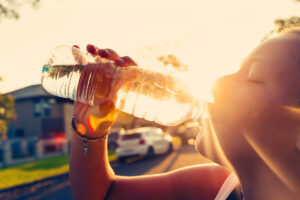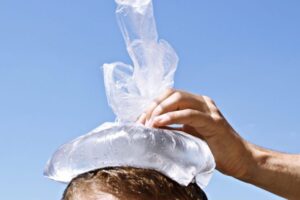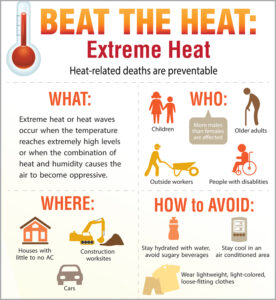Dealing With Extreme Heat
Last week was hot enough to fry an egg on the sidewalk—well almost. If the air is hot enough, sidewalks can heat up to about 145°; a temperature of 158° can fry an egg. Maybe it wasn’t that hot, but so far, the summer of 2022 has been hotter than normal—especially the day the thermometer in my truck registered 103°.
Scientists define extreme heat as temperatures that are much hotter and/or humid than average, which is what we’ve experienced recently. Under normal conditions, your body can easily cool itself by sweating. But during extreme heat, your body’s ability to cool itself may not keep up.

If you’re not careful, you can find yourself in a situation where your body temperature rises faster than it can cool itself. If you don’t take measures to cool down, you could become a victim of a heat-related illness like heat exhaustion or heat stroke. Every year approximately 650 people die in the United States from excessive heat stress.
The normal signs of heat stress include thirst, tiredness, grogginess, and visual disturbances. Ignoring these signs will cause your cardiovascular system to struggle, and you could quickly end up in a dangerous situation.
Heat cramps, heat exhaustion, and heat stroke make up the major heat illnesses, in order of increasing severity. These heat-related illnesses occur more frequently in the elderly, overweight, and poorly conditioned individuals.
Heat Cramps
Heat cramps are severe, involuntary, sustained muscle spasms. They can occur during or after physical activity and result from an imbalance in the body’s fluid level and electrolyte concentrations.
The solution for heat cramps involves getting plenty of water and more salt. The average person needs 8 to 12 cups of water a day to handle normal activities and about 2400 mg of sodium a day to maintain a healthy electrolyte balance. Most of us don’t drink enough water to begin with, and many of us don’t get enough sodium because we’ve been told to avoid it at all costs.
A few tips to avoid heat cramps include:
- When you work in the heat and sweat constantly, you should drink one cup of water every 20 minutes.
- If you work in a hot climate for more than 2 hours, supplement your water consumption with sports drinks or add a pinch of salt (150 mg of sodium) to your water.
Heat Exhaustion
Heat exhaustion is the body’s response to an excessive loss of water and salt, which often happens during the first summer heat wave when people have not acclimated to the heat. Heat exhaustion occurs when your circulatory system can’t adjust to the rapid depletion of body fluids. Plasma volumes drop and your body directs blood circulation toward the skin for cooling. This drastically reduces central blood volume and makes it more difficult for your heart to keep up.
Symptoms of heat exhaustion include rapid pulse, headache, dizziness, weakness, and nausea.
A person who experiences symptoms of heat exhaustion should move to a cooler environment; remove unnecessary clothing; apply cold compresses to the head, face and neck; and sip cold water. If symptoms persist for more than 20 minutes, go to an emergency room or call 911.
 The best way to avoid heat exhaustion is to be proactive:
The best way to avoid heat exhaustion is to be proactive:
- Make sure you exercise regularly by strength training once a week and doing 30 minutes of physical activity every day.
- Maintain a healthy weight. Excess body fat acts like insulation. This is great in the winter, but it can cause real problems in the summer. Fat keeps heat deep in your body from travelling to your skin where it can dissipate. Obese people are 3.5 times more likely to experience heat exhaustion or heat stroke.
- Follow the example of animals. You seldom see wild animals running around in the hot part of the day. They are most active in the early morning and late evening, and they rest during the hottest periods of the day. If you need to work outdoors on a hot day, get outside before 10:00 am or after 6:00 pm.
Heat Stroke
Heat stroke, the most serious heat illness, requires immediate medical attention. Heat stroke occurs when the body’s core temperature reaches 105°. A person experiencing heat stroke will have an altered mental state, red skin, headache, fast pulse, and dizziness. Typically, a person experiencing a heat stroke has completely stopped sweating.
If someone you know exhibits heat stroke symptoms, call 911 immediately, then take aggressive steps to lower their body temperature. Move them to a cooler place. Take off as much clothing as possible. Put ice packs, cold compresses, and ice on as much of their body as possible. The quicker you act, the better. One in three people who survive a heat stroke end up with some sort of permanent disability.
The best way to avoid heat stroke–pay attention to how you feel.
- If you work in the heat and you start to feel dizzy or nauseous, stop and get to a cool place.
- Put cold compresses on your head, neck and back.
- Drink more water than you think you need and add some salt.
Overhydration Is the Key
Overhydrating and staying hydrated represent the most important things you can do to avoid a heat-related illness while you work in the heat. Remember, sweating is your body’s main way of cooling itself. Your body also cools itself by diverting blood flow from your internal organs to your skin where it can cool.

Sweating a lot in the hot sun can lead to more serious fluid loss, which reduces your blood plasma volume. This puts your body in somewhat of a crisis because your working muscles demand more blood flow at a time when your body tries to divert more blood to the skin’s surface for cooling. Once you become dehydrated, there is less blood available to divert to the skin for cooling because your body views muscle blood flow as more important.
Staying hydrated is the key to staying cool in the heat. But you lose more water when you work in a hot environment. The average person performing moderate activity for one hour at 80° will lose about 2 cups of water. That same person will lose 4 cups in an hour of moderate activity at 100°. For every 4 cups of sweat loss dehydration, your heart rate will increase by 8 beats per minute.
If you know you will soon work in extreme heat, follow this hydration plan to help your body keep you cool.
- Drink 2 cups of water before you go to bed the night before.
- Drink 2 cups of water immediately when you wake up.
- Drink 2 cups of ice water 20 minutes before physical activity in the heat.
- Drink one cup of ice water every 20 minutes while you work in the heat.
- Add a pinch of salt to your water if you work in the heat for more than 2 hours.
- Drink an additional two cups of water for every pound you lose from working in the heat.
Also, pay attention to your urine. If it’s yellow or dark, you’re not drinking enough water.
Stay Strong and Cool!
Bo Railey

